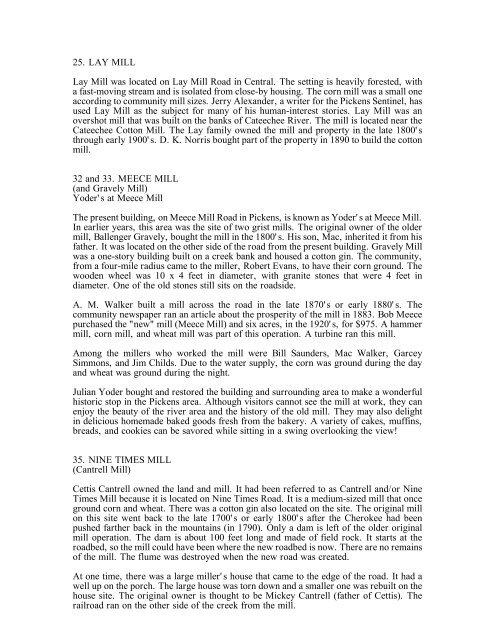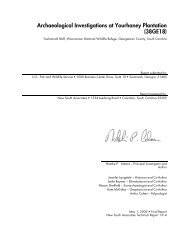Mills in the Upcountry: a Historic Context, and a Summary of a Mill ...
Mills in the Upcountry: a Historic Context, and a Summary of a Mill ...
Mills in the Upcountry: a Historic Context, and a Summary of a Mill ...
Create successful ePaper yourself
Turn your PDF publications into a flip-book with our unique Google optimized e-Paper software.
25. LAY MILL<br />
Lay <strong>Mill</strong> was located on Lay <strong>Mill</strong> Road <strong>in</strong> Central. The sett<strong>in</strong>g is heavily forested, with<br />
a fast-mov<strong>in</strong>g stream <strong>and</strong> is isolated from close-by hous<strong>in</strong>g. The corn mill was a small one<br />
accord<strong>in</strong>g to community mill sizes. Jerry Alex<strong>and</strong>er, a writer for <strong>the</strong> Pickens Sent<strong>in</strong>el, has<br />
used Lay <strong>Mill</strong> as <strong>the</strong> subject for many <strong>of</strong> his human-<strong>in</strong>terest stories. Lay <strong>Mill</strong> was an<br />
overshot mill that was built on <strong>the</strong> banks <strong>of</strong> Cateechee River. The mill is located near <strong>the</strong><br />
Cateechee Cotton <strong>Mill</strong>. The Lay family owned <strong>the</strong> mill <strong>and</strong> property <strong>in</strong> <strong>the</strong> late 1800' s<br />
through early 1900' s. D. K. Norris bought part <strong>of</strong> <strong>the</strong> property <strong>in</strong> 1890 to build <strong>the</strong> cotton<br />
mill.<br />
32 <strong>and</strong> 33. MEECE MILL<br />
(<strong>and</strong> Gravely <strong>Mill</strong>)<br />
Yoder' s at Meece <strong>Mill</strong><br />
The present build<strong>in</strong>g, on Meece <strong>Mill</strong> Road <strong>in</strong> Pickens, is known as Yoder' s at Meece <strong>Mill</strong>.<br />
In earlier years, this area was <strong>the</strong> site <strong>of</strong> two grist mills. The orig<strong>in</strong>al owner <strong>of</strong> <strong>the</strong> older<br />
mill, Ballenger Gravely, bought <strong>the</strong> mill <strong>in</strong> <strong>the</strong> 1800' s. His son, Mac, <strong>in</strong>herited it from his<br />
fa<strong>the</strong>r. It was located on <strong>the</strong> o<strong>the</strong>r side <strong>of</strong> <strong>the</strong> road from <strong>the</strong> present build<strong>in</strong>g. Gravely <strong>Mill</strong><br />
was a one-story build<strong>in</strong>g built on a creek bank <strong>and</strong> housed a cotton g<strong>in</strong>. The community,<br />
from a four-mile radius came to <strong>the</strong> miller, Robert Evans, to have <strong>the</strong>ir corn ground. The<br />
wooden wheel was 10 x 4 feet <strong>in</strong> diameter, with granite stones that were 4 feet <strong>in</strong><br />
diameter. One <strong>of</strong> <strong>the</strong> old stones still sits on <strong>the</strong> roadside.<br />
A. M. Walker built a mill across <strong>the</strong> road <strong>in</strong> <strong>the</strong> late 1870' s or early 1880' s. The<br />
community newspaper ran an article about <strong>the</strong> prosperity <strong>of</strong> <strong>the</strong> mill <strong>in</strong> 1883. Bob Meece<br />
purchased <strong>the</strong> "new" mill (Meece <strong>Mill</strong>) <strong>and</strong> six acres, <strong>in</strong> <strong>the</strong> 1920' s, for $975. A hammer<br />
mill, corn mill, <strong>and</strong> wheat mill was part <strong>of</strong> this operation. A turb<strong>in</strong>e ran this mill.<br />
Among <strong>the</strong> millers who worked <strong>the</strong> mill were Bill Saunders, Mac Walker, Garcey<br />
Simmons, <strong>and</strong> Jim Childs. Due to <strong>the</strong> water supply, <strong>the</strong> corn was ground dur<strong>in</strong>g <strong>the</strong> day<br />
<strong>and</strong> wheat was ground dur<strong>in</strong>g <strong>the</strong> night.<br />
Julian Yoder bought <strong>and</strong> restored <strong>the</strong> build<strong>in</strong>g <strong>and</strong> surround<strong>in</strong>g area to make a wonderful<br />
historic stop <strong>in</strong> <strong>the</strong> Pickens area. Although visitors cannot see <strong>the</strong> mill at work, <strong>the</strong>y can<br />
enjoy <strong>the</strong> beauty <strong>of</strong> <strong>the</strong> river area <strong>and</strong> <strong>the</strong> history <strong>of</strong> <strong>the</strong> old mill. They may also delight<br />
<strong>in</strong> delicious homemade baked goods fresh from <strong>the</strong> bakery. A variety <strong>of</strong> cakes, muff<strong>in</strong>s,<br />
breads, <strong>and</strong> cookies can be savored while sitt<strong>in</strong>g <strong>in</strong> a sw<strong>in</strong>g overlook<strong>in</strong>g <strong>the</strong> view!<br />
35. NINE TIMES MILL<br />
(Cantrell <strong>Mill</strong>)<br />
Cettis Cantrell owned <strong>the</strong> l<strong>and</strong> <strong>and</strong> mill. It had been referred to as Cantrell <strong>and</strong>/or N<strong>in</strong>e<br />
Times <strong>Mill</strong> because it is located on N<strong>in</strong>e Times Road. It is a medium-sized mill that once<br />
ground corn <strong>and</strong> wheat. There was a cotton g<strong>in</strong> also located on <strong>the</strong> site. The orig<strong>in</strong>al mill<br />
on this site went back to <strong>the</strong> late 1700' s or early 1800' s after <strong>the</strong> Cherokee had been<br />
pushed far<strong>the</strong>r back <strong>in</strong> <strong>the</strong> mounta<strong>in</strong>s (<strong>in</strong> 1790). Only a dam is left <strong>of</strong> <strong>the</strong> older orig<strong>in</strong>al<br />
mill operation. The dam is about 100 feet long <strong>and</strong> made <strong>of</strong> field rock. It starts at <strong>the</strong><br />
roadbed, so <strong>the</strong> mill could have been where <strong>the</strong> new roadbed is now. There are no rema<strong>in</strong>s<br />
<strong>of</strong> <strong>the</strong> mill. The flume was destroyed when <strong>the</strong> new road was created.<br />
At one time, <strong>the</strong>re was a large miller' s house that came to <strong>the</strong> edge <strong>of</strong> <strong>the</strong> road. It had a<br />
well up on <strong>the</strong> porch. The large house was torn down <strong>and</strong> a smaller one was rebuilt on <strong>the</strong><br />
house site. The orig<strong>in</strong>al owner is thought to be Mickey Cantrell (fa<strong>the</strong>r <strong>of</strong> Cettis). The<br />
railroad ran on <strong>the</strong> o<strong>the</strong>r side <strong>of</strong> <strong>the</strong> creek from <strong>the</strong> mill.







